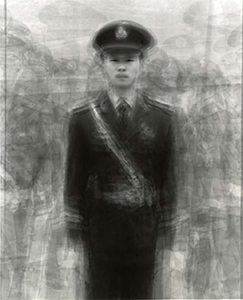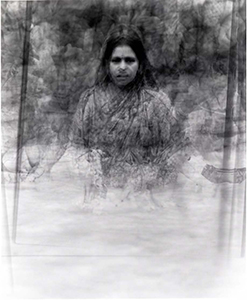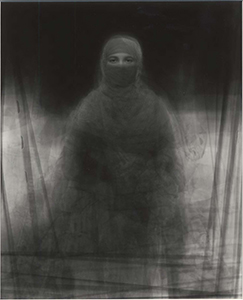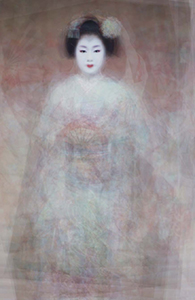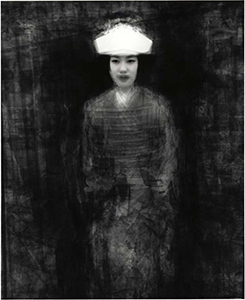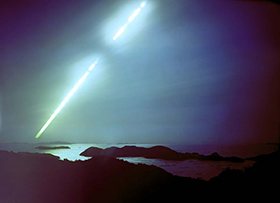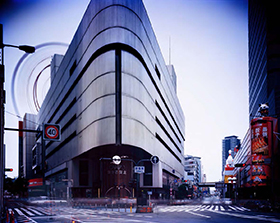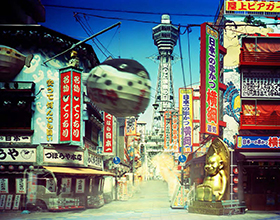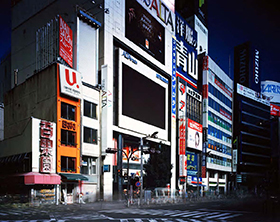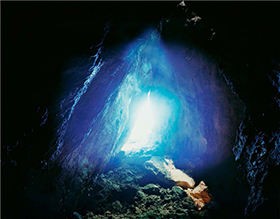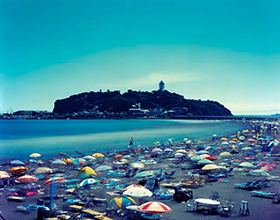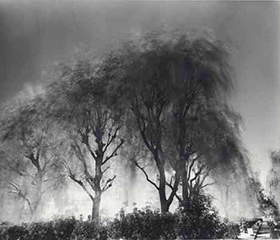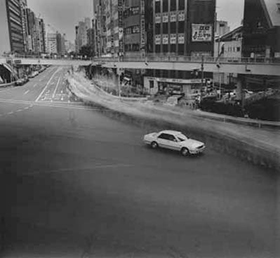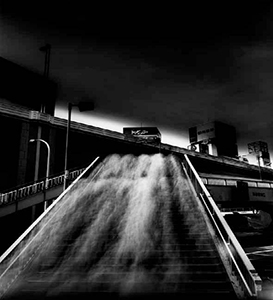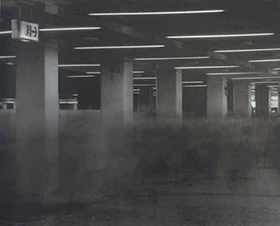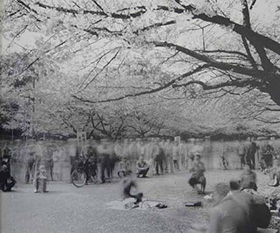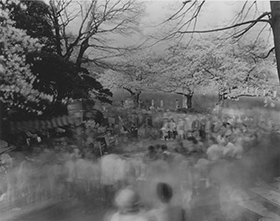As a person existing
Almost ten years have past since the 21st century started. What kind of decade was that which in Japan is called the Lost Decade, the 90s, that last part of the 20th century? As there was in this time many major events occurring which will stay in the memory of future generations, I was deliriously forging my own personal path in photography. Now, 20 years on, I would like to look back on my fondly-remembered Encounter with the World.
It was 1989 when I started shooting the series, City Flow and Fusion In Japan, it was the end of the bubble economy. Rather than being chaotic, everything was sparse and diluted. I was nineteen. In short, I was nearly stifled in those days.
Ever since I reached the age of reason and increasingly as I approached adulthood, I was aware of intense pressures to assimilate, to become like my surroundings, to become socially homogenized. As if this homogenized coercion were not enough, it also seemed as if society were becoming, wherever I turned, an unfathomable and hostile, endless, foreign void outside me, without direction or any space destined specifically for my self. Objects’ contours disappeared, leaving nothing to confront. This lack of something to give me a grip on reality, this frustration, haunted me constantly. I didn’t know where I was, what I was seeing, or what to think. But every time I was struck by this inability to perceive my own Reality, I wanted to take pictures.
[Extracted from a text written for my first exhibition in 1994. I.C.A.C. Weston Gallery in Tokyo.]
At first I took photographs of the rush-hour crowds in city centers. Places like Shinjuku, Shibuya, Shimokitazawa, Takadanobaba, Funabashi, Yokohama, etc. Everyday I wandered around Tokyo and its surrounding areas, shooting while not having any actual feeling of being alive and existing. I was convinced to the death with the idea that I would lose forever the chance to grasp the signs of my existence in this world if I didn’t shoot those pictures. I’m not the kind of photographer who takes quick street shots. From the very beginning, I used a slow shutter speed and a tripod. It was not that I wanted to make arty photographs, but rather that this way of working came to me naturally.
A photographer alternates between discoveries and despairs in the course of his endless Dialogue with Photography. His deed resembles both a gratuitous activity and a bet at the same time. In the course of pursuing his dialogue, his actions look like an attempt to find a light which can barely be found.
Because I adopted a slow shutter speed, moving people lost their contours and melted into the environment like water or smoke. Amid the continuous shooting of an enormous number of such images, how the world looked at that time gradually began to change for me. I felt a sense of wonder. I started to think that I was looking at a world with no contours, as if I was analyzing the world on a molecular level and had begun to regard the people in my photographs as particles of sand, and that that was the real condition of their existence. Then I came across the idea that I myself was also one of these grains of sand. The existence of people is extremely difficult to grasp, amorphous and fragile. Their contours are always fluid, but each figure holds its own equivalent position in photographs. (Actually, I found that silver grains and the amorphous existence of people share an almost equal existence when I look at my photographs with a loupe in the darkroom.) Through my photographs our collective existence was solid and beautiful. Although our existence is fairly tiny and difficult to distinguish, we are existing. Indeed, the world is present. I was crazy with joy to be able to have that feeling, even though just for a fraction of an instant. At that moment the reality that the world is inside of me and the reality that I am located in this world became completely one reality. When you look at the world, you should look at it from the outside at the same time that you should take a look at it from the inside. The view that straddles both inside and outside was one of the first miracles that photography literally gave to us. Since then I entirely lost interest in the way of looking at the world through “the conception of difference and the contrast between strong and weak.” To exist is enough. For the first time since I started to form my own thoughts, I felt I could now see the world. The world was glorious.
As is typical with those things called miracles, my awakening, and that of the world, this honeymoon period, didn’t last. In 1995 there occurred a devastating earthquake in Kansai, and soon after the deadly sarin attacks were carried out in the subway. Looking back now, I think that from that time it became rapidly difficult for me to imagine the existence of the world and of others “as the same as that of myself”. It was hard for me to imagine such terrible violence and the large amount of suffering occurring so close to me. I was shattered by my own lack of imagination that would prevent me from grasping a world connected without any boundaries. While the structure of the world was losing its symmetry at an overwhelmingly fast pace, I had a persistent feeling of nihility and was unable to shoot. The doors that had opened in front of me were slowly closing again. However, those who can see the light, even once, are happy. I myself, without any skepticism, can completely trust photography perfectly.
At the beginning of the 21st century, I undertook the portrait series entitled Our Face, in which I carefully superimposed the portraits of many people from all over the world onto a single sheet of photographic paper. Another project I’m working on now is called One Day, a landscape series taken in various places, in which I accumulate with long exposures the time and light of a single day onto a sheet of film. Both projects share an interest in imaging Time and Light as something accumulating, and in “every” person or “every” place being the subject. These two series are like those old days of the 1990s when I was absorbed in photography. All this time which leads to now is something that surely can’t be replaced. Therefore, my daily “dialogue with photography’ continues unbroken, even now.
I don’t have any firm convictions. All that I have are mere expectations. Even so, I don’t think it’s bad thing to live on the expectations for those photographs that I will take tomorrow.
Second miracle, that will last forever.
Ken Kitano, 2009
(Translated by Yu Hidaka)
I am an artist. I have been working on my project Our Face since 1999.
In the project, I visit various local areas around the world to take photos of the various groups of people living there.
On 35 mm film, I take photos of the people who form their respective communities, both old and new―people at work places, students at schools, groups of athletes, participants in traditional events and religious people. Then I create a portrait by evenly layering the images of the members of each group with a precise analog printing technique. In this globalization age, the project attempts to capture the world as an accumulation of localities. The resulting portraits are of equal value as images of a wide range of people with different thoughts, cultures, and customs.
On the other hand, the Our Face project is an ongoing process—I began the project in my own country Japan in 1999. Since 2008, I have been working on images of people across Asia, from the Middle East to East Asia. This should take about three to four years. In the near future, Asia is expected to account for half of the world’s population and is experiencing phenomenal economic growth, especially in countries like India and China. After Asia, I plan to spend a few years working on an American Continent series (South America, Central America, the Caribbean, and North America). After that, I will proceed to Eurasia and Africa. When I finish in Africa, I will have a layered and fused image of people from all walks of life from all over the world.
Please e-mail me and I will come to take photos of your group. I would be very happy if you would join this global-scale portrait project.
Ken Kitano
About the series One Day
In the landscape photograph series One Day which started in 2007, Kitano has tried to capture the time spent in specific locations such as Mabuni cave (Battlefield of World War II) Okinawa, Dotonbori, Osaka, a classroom at Sobudai high school, Kanagawa, the released point of the atomic bomb in Hiroshima, in front of Shinjuku Station, Tokyo, National Sanatorium Nagashima-Aiseien, Okayama (Nagashima, Isolated island of Medical center of Hansen's disease), and the Tower of Tsutenkaku, Osaka. Each image was taken by long exposure during the day from sunrise to sunset. Today, globalization makes it possible to easily access any place, exchange information quickly and efficiently, and choose from a diverse range of goods. In a contrasting situation, it deprives us of a sense of co-existing and diminishes the opportunity to imagine escaping through passages of time and space, away from our own locale. As same as the portrait series Our Face, Kitano wishes that the series “one day” will present a direction for viewers to imagine the world.
Ken Kitano
1968 Born in Tokyo.
Early 1980s In his early teens, Ken Kitano buys his first Camera and begins submitting works to photography contests. As his interests. As his interest in the world of photography grows from high school on, he begins to collect books by and about such noted Japanese photographers as Ken Domon, Daido Moriyama, and Ikko Narahara, as well as foreign artists.
1987 Upon entering Nihon University’s College of Industrial Technology, he joins the photography club and, while on a joint picture-taking outing, visits the deserted artificial island Gunkanjima, which he later returns to, alone a half a dozen times.
1990 Begins the series of Tokyo cityscapes and photographic records he came to call ‘Yooyuusuru Toshi’(City flow and Fusion). Enters Intense Inc., a commercial photography production company.
1993 Leaves Intense Inc. to become a freelance photographer. Travels for India. 1998 Begin photography of the mural painting work of Mexico.
1999 Begin photography of the “our face” series.
One-person exhibitions:
1993 "City Flow and Fusion" I.C.A.C. Weston Gallery, Tokyo
2004 "our face" Gallery Place M, Tokyo
2006 ”our face” PHOTO GALLERY INTERNATIONAL, Tokyo
2009 “one day” MEM, Osaka
2010 ”Flow and Fusion” UP Field Gallery, Tokyo
Group exhibitions:
1997 "San Marino International Photo Meeting" , San Marino
2000 "Selection from the Collection: Humanscape - Among the People" Kiyosato Museum of Photographic Arts, Yamanashi
2006 “Photography Today 3”The National Museum of Art, Tokyo
2007 “TOWARDS A GAME OF PHOTOGRAPHY”, Kawasaki City Museum, Kawasaki 2008 "BMW Prize Nominee’s Group show / PARIS PHOTO 2008", Carrousel du Louvre, Paris
2009 "BMW Prize Nominee’s Group show / PARIS PHOTO 2009", Carrousel du Louvre, Paris
Award:
Society of Photography Award (2004)
New Photographer Award by The photographic Society of Japan (2007)
Public Collection:
Kiyosato Museum of Photographic Arts_Stage and Design Center of the New National Theatre Tokyo
The National Museum of Modern Art, Tokyo Kawasaki City Museum, Kawasaki Thyssen-Bornemisza Art Contemporary, Vienna
